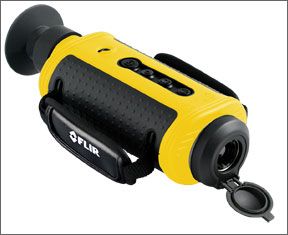I have seen several reviews of small radars, and have seen the photos from FLIR Systems cameras. The FLIR systems are still exorbitantly expensive, but considering the information presented by the FLIR and the interpretations needed for radar, why would anyone buy a new radar instead of waiting

Photo courtesy of FLIR Systems
288
for FLIR prices to drop?
Rob Ransone
1976 Herreshoff 19-foot catboat
Chesapeake Bay, Va.
Practical Sailor
FLIR bases its readings on thermal contrast, and objects that are the same temperature as their surroundings remain invisible. Take for example, a steel buoy or granite ledge that’s the same temperature as the sea surface at night. Another drawback: FLIR doesn’t offer any range or bearing information.
For normal navigation, radar is recommended, but a thermal-imaging camera is a great bonus tool.
Oil Filter
The oil filters for the Volvo D2-55 diesel (No. 3840525) in my Tayana Vancouver 42 are expensive and can only be obtained from a Volvo Penta dealer; including shipping, they run $21 each. I have tried every source I know and can’t find an aftermarket oil filter for this relatively new engine series. Does Practical Sailor have any suggestions for finding a suitable alternative?
Mike Hirko
Destiny, Tayana Vancouver 42
Gig Harbor, Wash.
Using less-expensive aftermarket alternatives often can save you cash, but when it comes to oil filters, not all are created equal. We’re not aware of any besides the Volvo Penta (www.volvopenta.com) filters that meet the exact same specs of the 3840525, but online forums (www.ybw.com) turned up a few user-recommended options from Fram and Coopers. However, users noted that these are smaller than the Volvo filters.
Volvo’s Doug Rose also said that he isn’t aware of any aftermarket filter that meets the specs of the 3840525. “Most engines companies source filters from filter specialists such as Fram or Wix,” Rose said. “But that doesn’t mean the Fram filter you find at Wal-Mart meets the engine-maker specifications, even though it screws on to the block and doesn’t leak.”
Rose explained that engine makers choose a filter based on a number of criteria that buyers should take into consideration when looking for an alternative. These include: the area and micron rating of the filter element; its resistance to crushing when partially loaded with dirt; whether it has or needs a by-pass valve that will allow oil to flow if the element is clogged; and the seal’s resistance to heat and compression when hot.
While you pay more for maker-specified parts now, you’re paying for peace of mind that they meet the needs of your engine. Just because a filter screws onto the engine’s threaded boss doesn’t mean it’s the right filter. It must be properly cross referenced. This information is available in catalogs available from filter makers.
Another thing to consider is that using a less-expensive, aftermarket filter may mean you have to change the filter more often, and in the end, won’t be seeing any significant savings. The Volvo filter for the D2-55 has a 500-hour change interval. That’s twice as long as some others.
Your best bet for finding an appropriate alternative would be to talk to others who own the same engine and have tried out different filters.
We found the 3840525 online for about $15 (plus shipping), within $5 of the cost of similar filters from Westerbeke and Yanmar. You can avoid the added expense of shipping by buying from a local distributor or ordering multiple filters at once. We see no problem using after-market filters whose reputations are proven—such as Fram, NAPA, Wix, Fleetguard, and Baldwin—but spending that extra $5 or so per filter may actually save you money in the long-term.


































